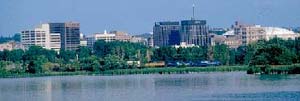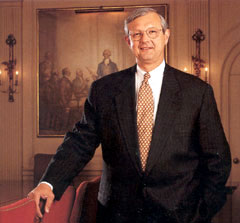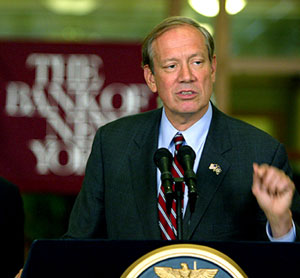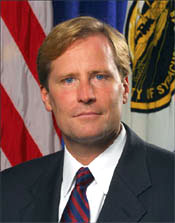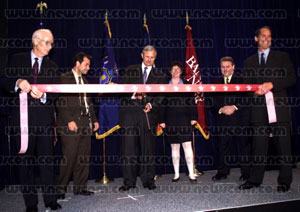|
Week of July 19, 2004 Blockbuster Deal from Site Selection's exclusive New Plant database |
|
LOOKING FOR A PREVIOUS STORY? CHECK THE
ARCHIVE.
Bank of NY
Adding as Many as 800 Jobs in Syracuse by JACK LYNE, Site Selection Executive Editor of Interactive Publishing SYRACUSE, N.Y. — The
Bank of New York (BONY at www.bankofny.com)
is branching out in a big way, announcing plans to add as many as
800 upstate jobs in Syracuse, N.Y. (www.syracusechamber.com).
The expansion is part of the company’s disaster-recovery strategy, forged by Sept. 11’s hard experiences. Among the huge cluster of New York-based banks, BONY took the worst financial hit. The bank’s Wall Street headquarters sits only a block from the World Trade Center’s Lower Manhattan site. That proximity led to pronounced physical disruption from 9/11’s attacks. With its head office badly damaged, the U.S.’s oldest bank scrambled. It temporarily relocated some 7,700 headquarters employees in part of the one million sq. ft. (90,000 sq. m.) of office space that BONY leased
Sept. 11’s aftermath. Technological disruption also staggered the organization. The devastation completely shut down BONY’s computer network, despite a backup system with two different telephone and power providers. Both providers, though, were in lower Manhattan. And both were knocked out. New Jersey-based backup centers quickly took over many functions. Still, BONY’s automatic teller machines were out of commission for nine days after Sept. 11. Moreover, the bank’s online bond business stagnated for a time as well. Customer information was still displayed accurately, only very slowly. The area didn’t have enough bandwidth left to rapidly process transactions. All told, the bank at the end of 2003 reported $743 million in expenses and lost revenue from 9/11; only $495 million was covered by insurance. “The need to increase the geographic diversity of our operations was critical. And it meant moving a portion of our work force outside of Lower Manhattan,” BONY CEO Thomas A. Renyi explained on July 1st after cutting the ribbon on the bank’s newly constructed 1,400-employee facility in Brooklyn.
Orlando a Major Contender
But the bank’s site search wasn’t confined to the Empire State’s borders.
“When the Bank of New York began making plans to expand, they reviewed their entire global operations to find the right location that offered the most opportunities for growth,” Gov. George Pataki (R) said at the project announcement.
BONY, in fact, had already gone far afield in dispersing operations. It picked Orlando, Fla., in April of 2003 for a new 70-employee securities-processing and brokerage-clearing center that will also act as a backup operation. Orlando was also a major contender for the new center. BONY has no retail bank branches in the Syracuse area, but it does have a 477-employee presence. The bank chose the Syracuse suburb of Dewitt in 2000 for a technology and operations center that it built in Sanders Creek Business Park. That presence played a significant role in the bank’s choice. BONY keeps an inordinately low profile. Its Dewitt center, for example, doesn’t even display the bank’s name. But project insiders say that labor quality was a major factor in BONY’s search, along with quality of life, easy airport access and strong surface infrastructure. The bank’s experience with area workers helped sway the decision, judging from officials’ pithy public remarks. “Onondaga County has provided the high-quality work force we require, and we look forward to expanding our employee base in the years ahead,” said BONY Senior Executive Vice President Donald R. Monks.
Added Pataki, “[This] decision to create up to 800 new jobs represents one of the largest commitments . . . in central New York in recent memory and will provide a tremendous boost to the region’s economy.” Bank Taking Niagara Power Space
BONY will initially add 350 new jobs at Dey’s Centennial Plaza, Monks
said. That downtown Syracuse location is a 10-minute drive from Hancock
International Airport, giving visiting headquarters executives rapid
in-and-out access. Syracuse Mayor Matt Driscoll, in fact, took a very productive 247-mile (395-kilometer) flight southeast several months ago. The mayor visited BONY officials at the bank’s New York City headquarters to make a key pitch for the city-owned downtown site, originally built in 1893 as Dey Bros. Department Store. “The former Dey Brothers Building, which has long been a treasure and symbol of retail’s dominance in the Syracuse economy, will now proudly signify our strength to attract international corporate leaders,” said Driscoll. “The importance of having the largest bank in the United States employing hundreds of people in our central business district speaks to the economic vitality that our city is enjoying.” Niagara Mohawk Vice President of Economic Development Marilyn Higgins added that the utility “is particularly pleased to have assisted . . . in bringing these new jobs into our headquarters city.” But Niagara Mohawk’s assistance wasn’t garden-variety: It helped market BONY’s new space. The utility at one point occupied 130,000 sq. ft. (11.700 sq. m.) on three floors of Dey’s Plaza. In downsizing, though, the company vacated the building, though it will continue to pay rent until its March 2005 lease expiration. But the Syracuse Economic Development Corp. is letting the utility out of the lease on Sept. 1 for the 39,000 sq. ft. (11,700 sq. m.) that BONY will lease.
After renovating the space, BONY will move in in September, employing 200 by year’s end and adding another 150 jobs by the end of 2005, Monks said. The Dey’s Plaza positions will include administrative, clerical, managerial and technical jobs, according to BONY officials.
Another Building in Dewitt?
It remains to be seen how close the bank comes to its best-case projected scenario of 800 total new jobs. Future work-force expansion will depend on market demand and business line growth, said executives with the bank, which was founded in 1784 by Alexander Hamilton.
If the company adds many of the 450 possible additional jobs, it will need more new space. The Dewitt center has a 600-employee capacity. One possibility is building a second facility in Sanders Creek, said Senior Vice President Frank Behlmer. BONY depicted two facilities in its original renderings for the park site, which is large enough to hold two buildings, bank officials say. But further expanding in Dey’s Plaza is also a possibility, Behlmer added.  Officials were quick to add that the Syracuse
and Orlando projects don’t signal the abandonment of the bank’s headquarters
home. BONY, in fact, signed a July 2002 agreement pledging to keep
7,700 jobs in New York City for 10 years — 6,160 in Lower Manhattan,
1,400 in the new Brooklyn building and 140 in Midtown.
Officials were quick to add that the Syracuse
and Orlando projects don’t signal the abandonment of the bank’s headquarters
home. BONY, in fact, signed a July 2002 agreement pledging to keep
7,700 jobs in New York City for 10 years — 6,160 in Lower Manhattan,
1,400 in the new Brooklyn building and 140 in Midtown.“New York state has been and will continue to be a vital business partner of the Bank of New York,” said Monks.
 PLEASE
VISIT OUR SPONSOR • CLICK ABOVE PLEASE
VISIT OUR SPONSOR • CLICK ABOVE 
©2004 Conway Data, Inc. All
rights reserved. Data is from many sources and is not warranted
to be accurate or current.
| |||||||||||||||
